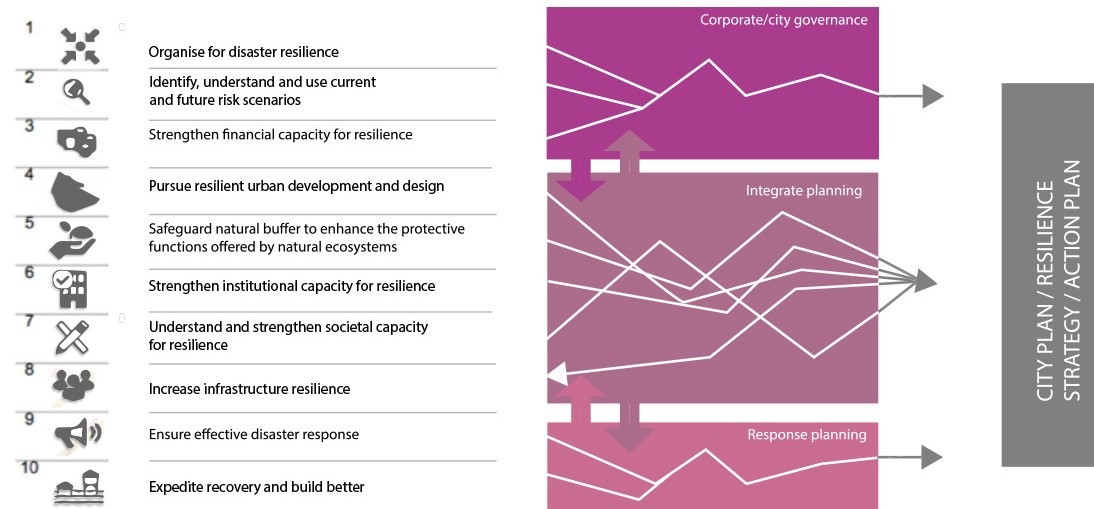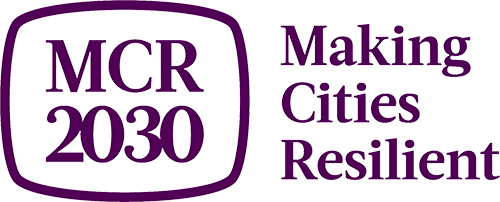The Ten Essentials for Making Cities Resilient
An operational framework of the Sendai Framework at the local level. A checklist for resiliency, and a great place for Stage A cities to start.
The Ten Essentials for Making Cities Resilient were developed to accelerate implementation of the Sendai Framework for Disaster Risk Reduction (2015-2030) at local level. The Ten Essentials map directly against the Sendai priorities of action and its indicators for monitoring actions on disaster risk reduction. They are the critical and independent steps that need to be undertaken to build and maintain resilience. This page provides the rationale for each Essential, pointing out strategic areas of intervention and identifying key actions. The actions identified under each Essential should be part of the overall disaster risk reduction and resilient planning process and influence urban development planning and design.

Essential 1
Organize for disaster resilience
Put in place an organizational structure with strong leadership and clarity of coordination and responsibilities. Establish Disaster Risk Reduction as a key consideration throughout the City Vision or Strategic Plan.
Why?
Having organizational structure and clear processes in place to respond to the key issues that affect urban resilience to natural hazards is imperative. Developing an organizational structure means strong leadership, clear delineation of responsibilities and coordination mechanisms, effective stakeholder engagement information dissemination and lines of communication, and well-defined risk reduction strategies and policies and mechanisms for risk reduction.
Essential 2
Identify, understand, and use current and future risk scenarios
Maintain up-to-date data on hazards and vulnerabilities. Prepare risk assessments based on participatory processes and use these as the basis for urban development of the city and its long-term goals.
Why?
Identifying probable and worst case risk scenarios based on the understanding of multiple and changing hazards, geographical and economic exposure, and vulnerabilities can inform current and future investment decisions that will contribute to improved resilience.
Essential 3
Strengthen financial capacity for resilience
Prepare a financial plan by understanding and assessing the significant economic impacts of disasters. Identify and develop financial mechanisms to support resilience activities.
Why?
Understanding the economic impact of disasters and developing financial mechanisms are essential to supporting resilience activities and strengthening opportunities for response and recovery.
Essential4
Pursue resilient urban development and design
Carry out risk-informed urban planning and development based on up-to-date risk assessments with particular focus on vulnerable populations. Apply and enforce realistic, risk compliant building regulations.
Why?
Pursuing resilient urban development based on risk-informed urban plans is essential to reducing current disaster risks and the prevention of future ones. Participatory urban planning processes and focus on vulnerable groups will not only decrease risk and facilitate the implementation of urban plans, but will also help in attaining equitable and sustainable development of urban communities.
Essential 5
Safeguard Natural Buffers to Enhance the Protective Functions Offered by Natural Ecosystems
Identify, protect and monitor natural ecosystems within and outside the city geography to sustain and safeguard their protective functions as natural buffers and enhance their use for risk reduction.
Why?
Identifying, protecting and monitoring natural ecosystems within and outside the city is imperative so that their protective functions as natural buffers are sustained and safeguarded Ecosystems and their services not only support city functions, such as water provision, but can also reduce risks from hazards and impacts of climate change. Together with ecosystems, green and blue infrastructure within urban areas have the potential to reduce risks from climatological as well as hydro-meteorological hazards.
Essential 6
Strengthen Institutional Capacity for Resilience
Strengthen all institutions related to a city’s resilience to have the capabilities to execute their roles and increase city’s resilience. Understand institutional capacity to help detect and strengthen gaps in resilience capacity.
Why?
Multiple organizations and stakeholders in a city have roles to play to reduce risk and increase their resilience. Strengthening institutional capacities including, but not limited to that of governmental organizations, private sector providing public services, industries, and academic, professional and civil society organizations) will increase the city’s resilience as a whole.
Essential 7
Understand and Strengthen Societal Capacity for Resilience
Identify and strengthen the social connectedness and culture of mutual help through community and government initiatives and multimedia channels of communication.
Why?
Social connectedness and a culture of mutual help have a major outcome on the impact of disasters of any given magnitude. Understanding patterns of social vulnerability, developing a culture of risk reduction and adequately addressing the needs of the most vulnerable significantly contribute to increasing the city’s coping capacity in the face of natural hazards. Social cohesion and community participation have been recognized as key factors for successful disaster risk management, and awareness-raising educational programs and trainings for the population have proven to help significantly in increasing preparedness. Unanimously recognized as a key factor for successful disaster risk management, and awareness-raising educational programs and trainings for the population have proven to significantly help in increasing preparedness.
Essential 8
Increase Infrastructure Resilience
Assess the capacity and adequacy of critical infrastructure and develop a plan or strategy for its protection, update and maintenance. Where needed ensure to develop protective, risk mitigating infrastructure.
Why?
Adequate and well-maintained infrastructure is critical to providing essential services, responding to disasters, and reducing the creation of risks from hazards and the impacts of climate change.
Essential 9
Ensure Effective Preparedness and Disaster Response
Ensure effective disaster response by creating and regularly updating contingency and preparedness plans, installing or linking with early warning systems and increasing emergency and management capacities.
Why?
Emergency preparedness and response plans save lives and property, and often contribute to resilience and post-disaster recovery by lessening the impact of a disaster. Preparedness efforts and early warning systems help ensure that cities, communities and individuals can act in sufficient time and reduce personal injury, loss of life and damage to property.
Essential 10
Expedite recovery and build back better
Establish strategies for post-disaster recovery, rehabilitation, and reconstruction ensuring that they are aligned with long-term planning and provide an improved city environment and increased resilience for the affected community.
Why?
Ensuring that recovery, rehabilitation, and reconstruction are collectively aligned with long-term planning goals will result in an improved city environment and increased resilience for the affected community. A well-planned and participatory recovery and reconstruction process helps the city reactivate itself, restore and rebuild its damaged infrastructure and recover its economy, empowering citizens to rebuild their lives, housing and livelihoods. This will also be a period to learn from past mistakes to develop sound rebuilding and development strategies.

